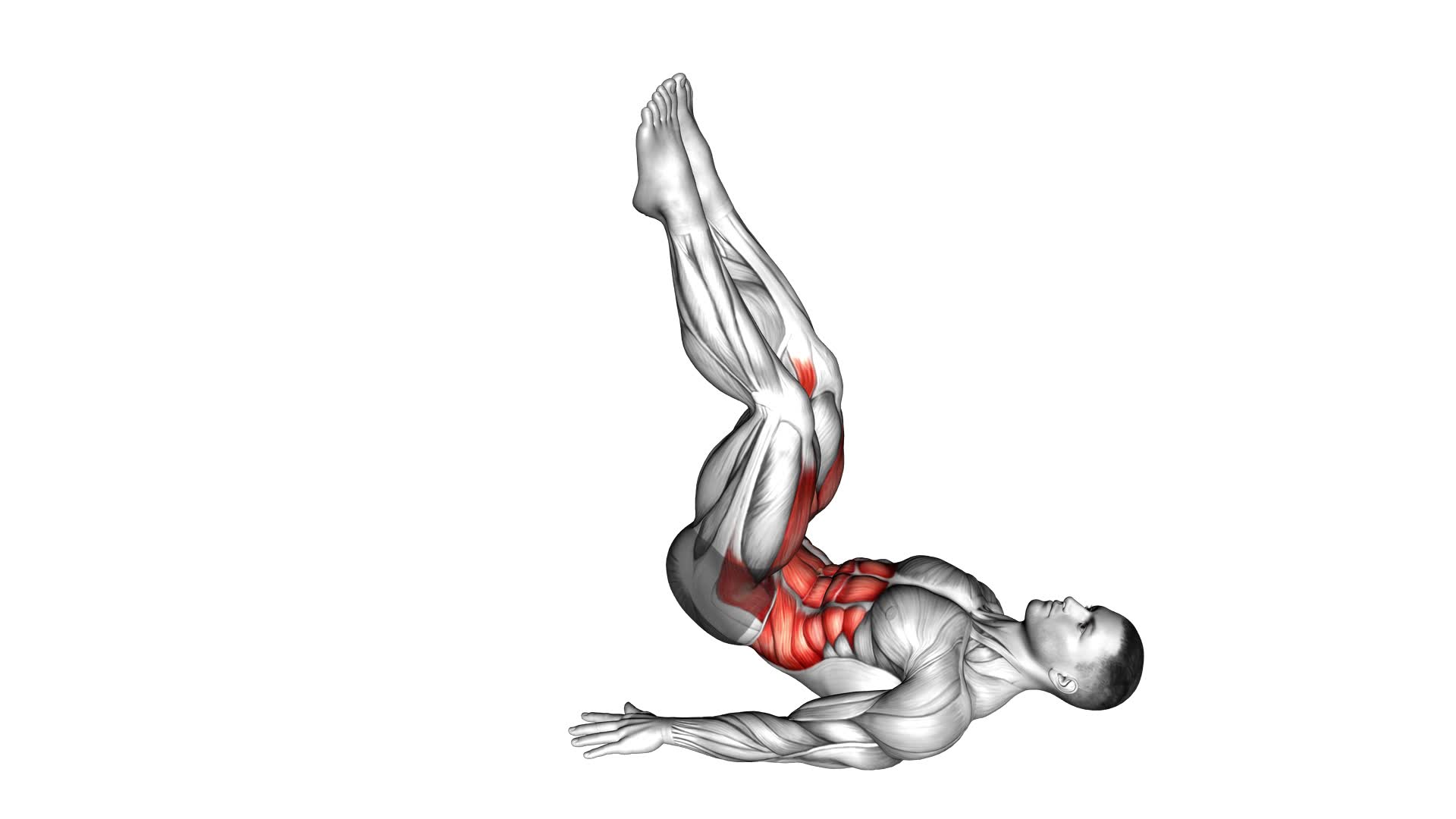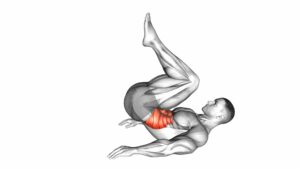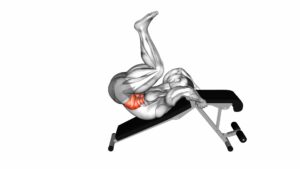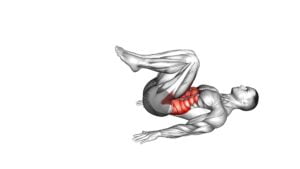Reverse Crunch (VERSION 2) – Video Exercise Guide & Tips

Looking to target your abs? Get ready to try the Reverse Crunch (Version 2)! This exercise is a great way to strengthen your core and sculpt those abdominal muscles.
Watch This Exercise Video
In this video exercise guide, we'll show you the proper form and technique, as well as common mistakes to avoid. Plus, we'll share modifications and tips to maximize the effectiveness of this move.
Get ready to level up your ab workout with the Reverse Crunch (Version 2)!
Key Takeaways
- The Reverse Crunch (Version 2) provides excellent back support.
- It strengthens abdominal muscles, including rectus abdominis and obliques.
- It targets hip flexors for improved posture and stability.
- The exercise offers modifications and variations for different fitness levels.
Benefits of the Reverse Crunch (Version 2)
You will frequently experience the benefits of the Reverse Crunch (Version 2) when incorporating it into your fitness routine.
This exercise provides excellent back support, making it a safe option for those with lower back issues or injuries.
By engaging your core muscles, the Reverse Crunch helps to strengthen your abdominal muscles, including the rectus abdominis and the obliques.
Additionally, it targets the hip flexors, which play a crucial role in maintaining proper posture and stability.
The Reverse Crunch (Version 2) also offers modifications and variations to suit different fitness levels and goals.
For beginners, you can start by performing the exercise with bent knees or using a stability ball for added support.
As you progress, you can increase the intensity by straightening your legs or adding resistance with ankle weights.
This versatility allows you to continually challenge your muscles and prevent plateauing.
Incorporating the Reverse Crunch (Version 2) into your routine won't only help you achieve a stronger core but also improve your overall stability and posture.
Proper Form and Technique for the Reverse Crunch (Version 2)
To perform the Reverse Crunch (Version 2) with proper form and technique, it's important to focus on back support during the exercise.
Make sure to keep your lower back pressed firmly against the ground throughout the movement to avoid strain or injury.
Additionally, engage your core muscles by actively contracting them as you lift your legs and hips off the ground, creating a strong and controlled movement.
Back Support During Exercise
To properly support your back during the Reverse Crunch (Version 2), ensure that you engage your core muscles throughout the exercise. Back support is crucial to maintain proper form and prevent strain or injury.
As you lift your legs and hips off the ground, focus on drawing your belly button towards your spine, activating your deep abdominal muscles. This will help stabilize your spine and protect your lower back.
By engaging your core, you create a strong foundation for the movement, allowing your back to stay supported and reducing the risk of discomfort or pain.
Remember to maintain this core engagement throughout the entire exercise for optimal back support and effective results.
Engaging Core Muscles
Maintaining core engagement is essential for proper form and technique in the Reverse Crunch (Version 2), ensuring effective results and preventing strain or injury.
Engaging your core muscles during this exercise not only helps to strengthen your abs but also aids in back pain prevention. By keeping your core muscles activated, you provide stability and support to your spine, reducing the risk of injury or discomfort.
To engage your core, focus on pulling your belly button towards your spine, tightening your abdominal muscles throughout the movement. This will help to create a stable and controlled motion, maximizing the benefits of the exercise and minimizing the strain on your lower back.
Regularly performing the Reverse Crunch (Version 2) with proper core engagement will improve your core strength and contribute to a stronger, healthier back.
Common Mistakes to Avoid During the Reverse Crunch (Version 2)
To perform the reverse crunch (Version 2) effectively, it's important to maintain proper form throughout the exercise. This means keeping your lower back pressed against the floor and avoiding any swinging or jerking motions.
Another common mistake to avoid is holding your breath during the movement. Remember to breathe steadily and engage your core muscles throughout the exercise for maximum effectiveness.
Proper Form Importance
Ensure you're executing the reverse crunch (Version 2) with proper form to avoid common mistakes. Proper form is crucial for maximizing the benefits of this exercise and preventing injury. Here are some key reasons why maintaining proper form and engaging your core are important:
- Maximize effectiveness: Proper form ensures that you're targeting the right muscles and getting the most out of each repetition.
- Prevent strain and injury: Engaging your core helps to stabilize your spine and protect your lower back from unnecessary strain.
- Enhance muscle activation: By maintaining proper form, you activate the correct muscles, such as the rectus abdominis and the obliques, leading to better strength and definition.
- Improve overall posture: Engaging your core during the reverse crunch helps to improve your posture by strengthening the muscles responsible for spinal alignment.
Breathing Techniques During
As you progress to the subtopic of breathing techniques during the reverse crunch (Version 2), it's important to focus on your breath and maintain proper form to avoid common mistakes. Incorporating proper breathing techniques can enhance your core activation and overall performance during this exercise.
When performing the reverse crunch, exhale as you lift your hips off the ground and contract your abdominals. This exhalation helps to engage the deep core muscles and maximize the effectiveness of the movement. Inhale as you lower your hips back down to the starting position. Remember to breathe steadily throughout the exercise and avoid holding your breath.
By incorporating proper breathing techniques, you can ensure that you're effectively engaging your core muscles and achieving the desired results.
Now, let's move on to the next section about engaging core muscles.
Engaging Core Muscles
To engage your core muscles effectively during the reverse crunch (Version 2), avoid these common mistakes:
- Relying solely on momentum: Engaging your core muscles requires controlled movements, so avoid using momentum to swing your legs up. Instead, focus on using your abdominal muscles to lift your hips off the ground.
- Neglecting proper form: Make sure your lower back stays pressed against the floor throughout the exercise. Arching your back can reduce the engagement of your core muscles and put unnecessary strain on your spine.
- Using your neck and shoulders: Keep your neck and shoulders relaxed during the reverse crunch. Excessive tension in these areas can detract from engaging your core muscles effectively.
- Not breathing properly: Remember to exhale as you lift your hips off the ground and inhale as you lower them back down. Proper breathing technique helps engage your core muscles and improves stability.
Now that you know how to engage your core muscles, let's explore modifications and variations of the reverse crunch (Version 2).
Modifications and Variations of the Reverse Crunch (Version 2)
Explore different ways to modify and vary your Reverse Crunch (Version 2) for a more challenging and effective workout.
By making small modifications to your Reverse Crunch, you can engage different muscle groups and intensify the exercise.
One modification you can try is the Weighted Reverse Crunch. To do this, hold a dumbbell or a weight plate against your chest while performing the exercise. This added weight will increase the resistance and make your core muscles work harder.
Another variation is the Bicycle Reverse Crunch. Instead of lifting both legs at the same time, lift one leg while bending the other knee towards your chest. Alternate between legs in a cycling motion, engaging your obliques and adding a rotational component to the exercise.
You can also try the Stability Ball Reverse Crunch. Place a stability ball between your legs and lift it as you perform the reverse crunch. This won't only target your core muscles but also challenge your balance and stability.
Lastly, if you want to increase the difficulty even further, you can perform the Reverse Crunch on a decline bench. This will require more core strength and stability as you fight against gravity.
Remember to always listen to your body and choose modifications that suit your fitness level.
Tips to Maximize the Effectiveness of the Reverse Crunch (Version 2)
To maximize the effectiveness of your Reverse Crunch (Version 2), focus on maintaining proper form and engaging your core muscles throughout the entire exercise. Here are some tips to help you get the most out of this workout:
- Keep your back supported: Place your hands on the floor beside you or use a yoga mat for extra cushioning and support. This will help prevent any unnecessary strain on your lower back.
- Engage your core: Throughout the exercise, be sure to actively squeeze your abdominal muscles. This won't only make the exercise more challenging, but it will also help to strengthen and tone your core.
- Control your movements: Slowly lift your hips off the floor and bring your knees towards your chest. Avoid using momentum or swinging your legs, as this can reduce the effectiveness of the exercise. Focus on using your abs to control the movement.
- Modify as needed: If you find the Reverse Crunch (Version 2) too challenging, you can modify the exercise by bending your knees and placing your feet flat on the floor. This can help reduce the strain on your lower back and make it easier to engage your core.
Incorporating the Reverse Crunch (Version 2) Into Your Workout Routine
After incorporating the tips mentioned earlier, you can now start including the Reverse Crunch (Version 2) into your workout routine. To ensure proper form and prevent any strain on your back, it's important to use back support while performing this exercise. You can use a mat or an exercise ball to provide cushioning and stability for your lower back. Placing your hands under your glutes can also provide additional support.
When performing the Reverse Crunch (Version 2), it's crucial to pay attention to your breathing techniques. Exhale as you lift your legs and hips off the ground, engaging your core muscles. Inhale as you slowly lower your legs back down to the starting position. This controlled breathing pattern will help you maintain stability and maximize the effectiveness of the exercise.
To incorporate the Reverse Crunch (Version 2) into your routine, start by performing 2-3 sets of 10-12 repetitions. As you become more comfortable and stronger, you can gradually increase the number of sets and repetitions. It's important to listen to your body and make adjustments as needed.
Remember to always warm up before starting any exercise routine and consult with a fitness professional if you have any concerns or questions. By incorporating the Reverse Crunch (Version 2) into your workout routine, you can strengthen your core muscles and improve your overall fitness level.
Frequently Asked Questions
How Many Calories Does the Reverse Crunch (Version 2) Burn?
The reverse crunch (version 2) is a great exercise to incorporate into your full body workout routine.
Not only does it target your abdominal muscles, but it also engages your hip flexors and lower back.
When performed properly, this exercise can help strengthen your core and improve your overall stability.
As for the number of calories burned, it varies depending on factors such as your weight, intensity, and duration of the exercise.
Can the Reverse Crunch (Version 2) Help Reduce Belly Fat?
The reverse crunch (version 2) is a great exercise for toning your abdominal muscles. It targets the lower abs and can help reduce belly fat when combined with a healthy diet and regular cardio exercise.
To make the reverse crunch (version 2) more challenging, you can try adding weights or incorporating modifications like leg raises. However, keep in mind that spot reduction isn't possible, so it's important to focus on overall fat loss for a toned midsection.
Is the Reverse Crunch (Version 2) Suitable for Beginners?
The reverse crunch (version 2) is definitely suitable for beginners! To perform it with proper form and technique, lie on your back with your hands behind your head and your knees bent.
Lift your hips off the ground and bring your knees towards your chest, using your abs to initiate the movement.
For beginners, you can start with smaller range of motion and gradually increase as you get stronger. Remember to engage your core throughout the exercise for maximum effectiveness.
How Often Should I Incorporate the Reverse Crunch (Version 2) Into My Workout Routine?
To get the most out of your workout routine, it's important to incorporate the reverse crunch (version 2) regularly.
This exercise is great for targeting your core muscles and building strength.
By adding it to your routine, you'll experience benefits like improved stability and better posture.
Don't worry if you're a beginner, there are variations and modifications available for different fitness levels.
Are There Any Potential Risks or Injuries Associated With Performing the Reverse Crunch (Version 2)?
When doing the reverse crunch (version 2), it's important to be aware of potential risks and injuries. Make sure you take necessary precautions and use proper technique to avoid any harm.
Common mistakes include using momentum and pulling on the neck. To prevent these, engage your core and focus on controlled movements.
If you're concerned, consult a professional or try alternative exercises like planks or leg raises.
Conclusion
In conclusion, the reverse crunch (version 2) is an effective exercise for strengthening the core and targeting the lower abdominal muscles. By maintaining proper form and avoiding common mistakes, you can maximize the effectiveness of this exercise.
Additionally, incorporating modifications and variations can add variety and challenge to your workout routine. Remember to always listen to your body and consult with a fitness professional if you have any concerns or questions.
Keep up the good work and enjoy the benefits of a strong core!

Author
Years ago, the spark of my life’s passion ignited in my mind the moment I stepped into the local gym for the first time. The inaugural bead of perspiration, the initial endeavor, the very first surge of endorphins, and a sense of pride that washed over me post-workout marked the beginning of my deep-seated interest in strength sports, fitness, and sports nutrition. This very curiosity blossomed rapidly into a profound fascination, propelling me to earn a Master’s degree in Physical Education from the Academy of Physical Education in Krakow, followed by a Sports Manager diploma from the Jagiellonian University. My journey of growth led me to gain more specialized qualifications, such as being a certified personal trainer with a focus on sports dietetics, a lifeguard, and an instructor for wellness and corrective gymnastics. Theoretical knowledge paired seamlessly with practical experience, reinforcing my belief that the transformation of individuals under my guidance was also a reflection of my personal growth. This belief holds true even today. Each day, I strive to push the boundaries and explore new realms. These realms gently elevate me to greater heights. The unique combination of passion for my field and the continuous quest for growth fuels my drive to break new ground.







